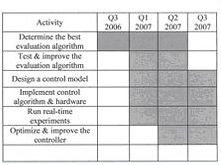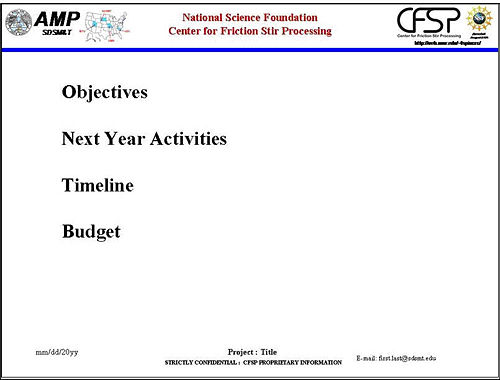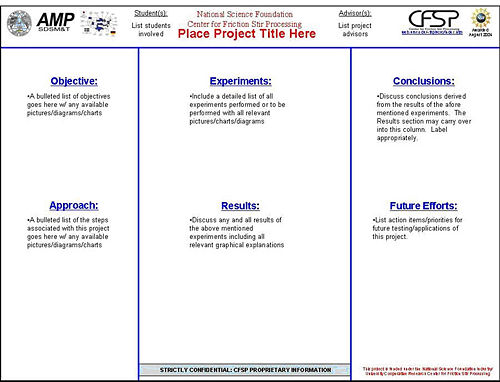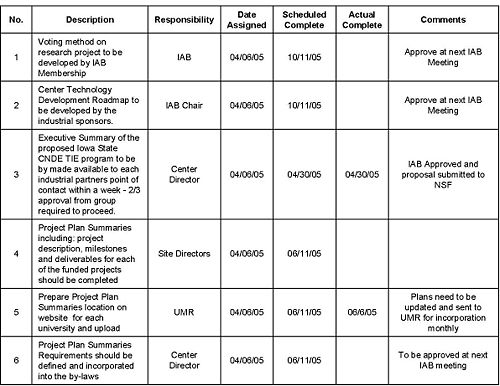Meetings
From Center for Friction Stir Processing Guide
Contents |
CENTER MEETINGS
There are three types of meetings that are essential to center operations: Semi-Annual IAB Meetings with the Industrial Advisory Board (IAB), Midterm meetings with site specific sponsors, and weekly meetings at local sites. IAB Meetings are a critical part of the management process. These are the primary method whereby the progress of the center is reviewed and new growth directions may be added to the Technology Roadmap. Various center assessments and reports (Section 5) are prepared, uploaded to the CFSP Website, and sent to the entire IAB Membership.
During the meetings, new projects may be proposed and accepted. Center business such as new university site applications, new IAB sponsorships, intellectual property issues, paper and publications, etc., is conducted. The meeting serves as the primary mechanism by which all parties review the progress of current projects. All IAB sponsors are invited to the spring and fall meetings, while only the university-affiliated sponsors attend the mid-term meetings.
Semi-Annual Industrial Advisory Board (IAB) Meetings
The IAB meetings are held twice each year. The fall IAB meeting is held at the CFSP Lead Institution (SDSMT) with the location of the spring IAB meeting rotating between the other university sites. The format of the CFSP spring and fall IAB meeting agenda is similar, with a technical-interchange workshop held the day before the management-review meetings.
IAB Meeting Participants
Industry sponsors, NSF representatives, the external evaluator, the Center Director, Site Directors, students, and faculty convene at the IAB meetings to discuss current and future projects. Multiple representatives from an industry sponsor are eligible to attend the meeting, but only one vote may be cast per membership. Note, however, that some industry partners may affiliate with more than one university site, in which case the number of votes is equal to the number of paid memberships.
Although not officially part of the CFSP, representatives from CFSP I/UCRC TIE programs are invited to make presentations on their projects at the meeting. With the exception of these TIE program participants (See Appendix B - Article 7.5), center meetings are closed to the public and limit attendance to those affiliated with the center. A sign is posted on the meeting room doors showing this attendance restriction.
When scheduling a large number of people, conflicts with other obligations are inevitable. A recent addition to the meetings is the use of web meeting tools. These tools, such as GoToMeeting (http://www.gotomeeting.com/) and WebEx (http://www.webex.com), provide the remote attendee with the capability to broadcast the display to anyone attending the meeting at any location. Thus, a person in Virginia, for example, can control a PowerPoint presentation or software demonstration from his or her machine and have the contents of that computer screen projected at the meeting in South Dakota and viewed by other remote attendees in Germany and Brazil.
To date, the 30-day free trial feature of GoToMeeting has been used for IAB Meetings, but the SDSMT AMP site is considering a subscription that allows all participating university sites to use this, or another, web meeting tool.
If the presentation is being projected to an audience, provisions must be made to amplify the audio portion of the presentation. Note that lack of readability, a common issue with presentations and software demonstrations, can also be addressed by this software. All meeting attendees, regardless of location, can join the on-line meeting and view the presentation on their individual computer screens.
Again, a conference call or similar web-based audio broadcast must be arranged for participants at remote locations. Managing the group discussions with a large number of members participating via the web is a difficult task and must be controlled by the Center Director. While this off-site IAB meeting participation option is provided, on-site member participation is strongly encouraged.
Setting the IAB Meeting Agenda
A unique feature of the annual meetings as conducted by the CFSP is the addition of a workshop, or technical interchange meeting, on the day before the official IAB meeting is convened. This process, as well as the content of the IAB meetings, is described below.
The agenda is set by the IAB Chair and the Center Director with input from the Site Directors, the NSF Program Director, and Independent Evaluator (Appendix K). The format of the meetings is well standardized with a Pre-IAB Meeting Technical Workshop (Section 4.1.3) followed by the IAB Management Review Meeting (Section 4.2).
Once the agenda is established, it is published on the center’s website at the required time period before the meeting (Appendix B) and sent to the entire IAB Membership using the IAB Meeting Invitation Form (Appendix E).
The agenda for the meeting is set by the board members as described above. A sample CFSP Workshop and IAB Review Meeting Agenda is presented Appendix K. However, certain elements are routinely placed on the agenda. These include:
- The State of the Center Address (Section 4.2.3)
- LIFE form evaluation of projects
- A session on Center business
- A review of the Technology roadmap (Section 5.3)
Once the agenda is finalized, it is forwarded to the I/UCRC Independent Program Evaluator (IPE) in preparation of the I/UCRC LIFE Form - Level of Interest and Feedback Evaluation – project-review process (Section 4.2.2). The IPE registers a CFSP IAB Meeting at the University of Central Florida LIFE web tool (http://www.isl.ucf.edu/LIFE/) and assists the CFSP Center Director and staff in populating forms with the project numbers, project titles, and investigator names that will be reviewed at the IAB Review Meeting.
All presenters and posters, including Center Business related presentations, are responsible for uploading their presentation onto the center’s website one month before the annual meeting. This allows all IAB technical representatives adequate time to review the information and prepare for discussion. All documents uploaded are identified per the CFSP naming conventions (Section 3.11).
The host site includes a social event with each IAB meeting. The CFSP has traditionally held a group dinner with an event of local significance, such as a trip to Mt. Rushmore or Crazy Horse in South Dakota, a riverboat ride in Missouri, or a trip to a ski resort in Utah. Social events provide an informal venue for conducting business and for creating relationships between sponsors and university faculty, staff, and student researchers.
Pre-IAB Meeting Technical Workshops
The pre-meeting workshop session is scheduled for the day before the IAB management-review sessions at both the fall and spring meetings. This workshop is a technical-interchange meeting where ideas are presented by both university and industry members. The Site Directors select the theme and scope of the presentations for their site – within the strict time limitations of the agenda (Appendix K). Not all projects may be presented. Industry sponsors are encouraged to present their specific research and development needs to the entire group.
The purpose of these presentations is to make the center members aware of the on-going, completed, and proposed projects from a purely technical perspective. Evaluation, proposed changes, progress toward benchmarks, and other items are discussed at the management-review meeting the following day. Items that are typically covered at workshop include:
- a technical review of projects by site, including completed, in progress, and proposed projects as selected by the Site Directors and site affiliated sponsors
- presentations by industry sponsors on industry needs
- review of projects for which supplemental funding was secured (e.g. an REU to document Best Practices in a multi-site center)
The technical reviews follow a standard template and are loaded onto the web site one month prior to the meeting. It may be necessary to upload a revised version of a presentation after the meeting to incorporate comments and suggestions made by the board. The format for the workshop technical review generally includes the project title and personnel involved the project objectives, approach, status, immediate actions, schedule, and outstanding issues. Each of these sections is subdivided into tasks and subtasks for each year of the project. Projects titles and numbers are in accordance with the naming conventions of the center (Section 3.11).
As indicated, industry partners also make presentations during the IAB workshop. The content of the presentation varies based on individual sponsor needs. For example, a new industry sponsor will generally present an overview of the company and of the friction stir processing activities in which it is engaged. This introduction to personnel and projects provides a starting point for collaboration discussions and networking opportunities with the other members.
A sponsor who has made previous presentations will generally shorten the overview portion and concentrate on how current or future center activities integrate with their efforts. The presentation may also define how the center can meet a current or anticipated need. All industry sponsors are invited to make presentations, but generally only a few sponsors volunteer at each meeting. New members and members with significant developments to report are encouraged to place themselves on the agenda. Often, an IAB Sponsor will present an overview of a recommended research project that it wishes the CFSP to initiate.
Presentations at IAB Management Review Meetings
As noted above, several types of presentations are made during the IAB Management Review Meeting. The following sections describe the content of these presentations in greater detail.
Management-Review Presentations
At this meeting, a management summary is presented for each continuing and proposed project. This is a very brief overview of the project presented immediately prior to the completion of LIFE forms. (Note: technical discussions of these projects were completed at the workshop and social events). These presentations are made by the Site Directors or Project Investigators with student presentations not allowed.
The management summary starts by listing the students and faculty working on the project. Next, it gives a description of the objectives of the project, typically broken down into several tasks. Past progress on these objectives has already been presented and is not repeated here. Instead, the next year’s activities are laid out in a brief, bulletized format. This includes a project timeline, typically a chart that shows which tasks are planned to be done in each of the four quarters of the following year.
Finally, the management summary gives the proposed budget for the project- including any support from REU or RET supplement funding (Section 3.6) allocated to the project. The budget is often just a total dollar figure and is likely to be a fraction or multiple of sponsor fees since sponsors are directly tied to projects.
Management Review Meeting – Project LIFE Form Evaluations
The CFSP has defined a process for LIFE form evaluation of projects which has proven effective for timely feedback between sponsors and projects. As noted earlier, the technical-interchange workshop presented the day before the official IAB meeting is convened provides an opportunity for discussion of the technical details of current projects. However, sponsor feedback on the projects is not solicited until the official meeting begins.
An executive summary of each current, continuing, or new project is presented during the meeting with a focus on evaluating the sustainability and progress made during the last period. All presentations make use of a standard presentation template which gives the student guidance in the preparation of the presentation and creates a consistent look for the compiled presentations made available to the IAB Members at the meeting and on the web. The summaries are typically 15 minutes and include the objectives of the project, the approach taken, and a summary of the current year’s progress. A detailed description of the Executive Summary format is contained in Section 4.2.
IAB Members complete a LIFE form after each Executive Summary presentation. Prior to the IAB meeting, the projects to be evaluated are entered into the LIFE form website at the University of Central Florida (http://www.isl.ucf.edu/LIFE/). This site provides IAB participants with an excellent electronic tool for recording their evaluation of each project. A sample LIFE form is shown below. Note that new proposals are reviewed using the same LIFE form evaluation procedure used for current and continuing projects. The University of Central Florida web site given above also provides a summary of all LIFE form evaluations, which quickly identifies the level of interest of the members as a group.
While this is quite useful, the CFSP has added an additional step to the LIFE form evaluation process. IAB input on each project is collected and compiled between the first and second days of the meetings. The CFSP has developed a form into which all comments for a single project, as well as the project leader’s response to each comment, are entered. A sample LIFE form Response template is shown below. At present, the compilation is done by hand, but automation would be possible.
This process allows Site Directors to meet privately with sponsors to discuss their LIFE form evaluations and the Site Director’s response at the beginning of the second day of the meeting. Subsequently, the evaluations and responses are shared with the full IAB. The full board discusses the level of interest and the suggestions for changes, as well as the comments and responses for each project.
A summary of the process is:
IAB Review Meeting Day 1
- Management summaries of each continuing and proposed project are presented using a standard template. Student presentations are not allowed.
- Electronic LIFE form evaluations are completed on the web after each presentation. Note that laptop power and net connections are required for each IAB member attending.
- Electronic LIFE form Evaluations are download and sent to each of the Site Directors to prepare responses.
- LIFE form responses are prepared by Site Director and principle investigator for each project using the CFSP Life Form Response template.
- Discussions on projects continue at evening social events.
IAB Review Meeting Day 2
- Site-affiliated sponsors meet with the Site Director and project leaders to discuss responses to LIFE forms and adjust research plans as required. Sponsors with memberships at multiple sites attend the meeting of both. The outcome of this meeting is the site continuing and proposed project recommendations to be presented to the full board.
- Summary of evaluation statistics and LIFE form responses are presented to the full board for discussion.
- Thus, closure on potential changes, additions, and deletions can be made before the end of the meeting.
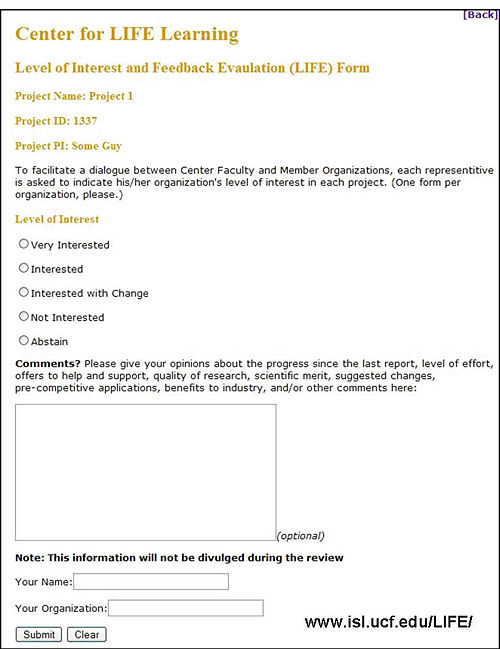

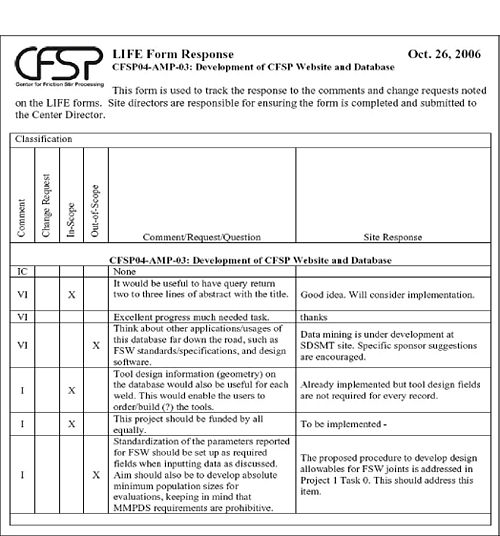
State of the Center Presentation
A unique feature of the CFSP IAB meetings is the opening of the session with a State of the Center report presented by the Center Director. The State of the Center presents an overview of center activities including:
- Reports on Site Directors' meetings held since the last IAB meeting
- The status of the action item list generated at the previous IAB meeting as well as those action items remaining from meetings prior to the last one
- Center funding details
- A summary of CFSP personnel demographics
- A summary of center activity relative to select goals defined by the center and the NSF including:
- The number of degrees awarded to students in the center
- The number of students hired by industry from the center
- The number and types of publications produced by center personnel
- The number of intellectual property events generated at the center
Three assessment tools provided within the State of the Center Report that have proven useful are the Review of Site Focus Research Areas (Section 2.1.3), the Technology Roadmap (Section 2.1.2), and the assessment of Center performance (Section 5) against NSF best practices for an I/UCRC.
As described in the Section 2.1.3 on establishing the center, one of the unique aspects of the CFSP is the structure agreed upon by the participating universities relative to division of focus areas. Once the mission of the center was established and the needs of industry were defined, the participating universities agreed upon specializations, or technological priorities, each would assume in furtherance of the center’s mission.
These technological priorities are re-examined at each IAB meeting in light of the changes that have occurred within the industry and the center. While the mission may remain constant, the means to achieve it evolve and adapt as new members are added to the center. The priorities overlap between sites in some cases, but every effort is made to prevent duplication of effort.
The Technology Roadmap is a tool developed by the CFSP to provide members with a visual representation of the center’s strategic plan. The items in the assessment rubric were selected from Ron Beck’s summary of best practices as identified by Center Directors in a 2004 survey. Both the roadmap and the assessment rubric are described in Section 5, Center Assessments.
Posters
Students and faculty who have technical information in addition to that shared in formal presentations present posters on their work. The students are aided by the deployment of a standard poster template which has the additional benefit of providing a consistent look to the compilation of poster presentations made available to the IAB. A sample of the poster template is shown below. Printed copies are made available to the IAB Members at the meetings and are also uploaded to the center web site for easy reference. The center bylaws require all presentations and posters to be uploaded 30 days prior to the meeting to give participants adequate time to study them.
Posters are displayed on walls and easels and are available for viewing before and after the formal sessions as well as during breaks. During scheduled breaks, students and faculty are available to discuss their work with center members. Students are encouraged to bring laptops to run demonstration programs at this time as well. IAB member feedback indicates a high level of satisfaction with the poster sessions.
Follow-Up from the IAB Meetings
Action Items
The action-item discussion held at each IAB meeting includes a summary of items to be added to the list, items completed since the last meeting, and items which require additional information or input from the board to facilitate resolution. The list and the current status of each item are maintained on the web site and available for all IAB Members to view. The ability to edit and update the action-item list is limited to the Center Director to ensure consistency. A sample of the action-item list from original Salt Lake City Planning Grant Interim IAB meeting is shown below.
Annual IAB Members Report
The Annual IAB Members Report is described in detail in Section 5. It contains a summary of center activity for the year including:
- Program Overview
- FSW Technology Development Roadmap (Section 2.1.2)
- Project Master Schedule (Section 5.3.3)
- Project Executive Summaries (Appendix L)
- Current Project Annual Technical Reports (Appendix M)
The Program Overview is prepared by the Center Director and provides the membership with information similar to that submitted to the NSF in the NSF Annual Report (Appendix O). MS-Word document templates are used for the Executive Summaries and the Project Annual Technical Reports to provide a consistent look across project reports and to reduce search time within a document. The Executive Summary gives an overview of the project including objectives and past year’s accomplishments. The template is set up to make the main points stand out, and the details are easy to fill in for the writer and easy to find for the interested reader. Members of the IAB will be scanning all of these executive summaries and want to be able to skim over projects that are not of immediate interest while being able to get detailed information on some projects. The template makes this a fairly painless process both for the writers and the readers of the document. A sample Executive Summary is found in Appendix L.
A hard-bound copy of the Annual Member's Report is provided to each sponsor and to each site, and an electronic copy is posted on the secured portions of the CFSP website under the Annual Meetings Section.
Quarterly Meetings
The IAB meeting is the primary mechanism for soliciting sponsor feedback, but additional meetings are scheduled between the university site and its affiliated IAB sponsors to ensure timely communication of current research progress and development of new research programs. The frequency of these meetings varies with the level of involvement and geographic proximity of the sponsor. Some sites are able to include sponsors in regular meetings while others are not.
At a minimum, Project Investigators and/or the Site Director arrange for a meeting with each sponsor between the semi-annual IAB meetings. These quarterly meetings may be held at the university or the industry sponsor’s facilities. As noted in Section 3, students and faculty working on a project complete Quarterly Reports which are uploaded to the CFSP database for access by the industry sponsor.
These reports, plus accompanying presentations using the standardized presentation templates, provide a framework for the quarterly meetings. These meetings provide detailed informal feedback on how the project’s direction can be fine-tuned to meet the evolving needs of the sponsor. Requests for significant changes in direction, however, may be identified but approval is reserved for the regular IAB meetings.
Weekly Meetings
Weekly meetings (See also Section 3.10) are held at each site as part of the internal project management structure. The students and faculty working on a project prepare PowerPoint presentations to explain their objectives and results to date to the entire group. The Site Director and, in the case of the AMP Center, the Center Director, provide feedback as do other students and faculty members of the overall research team. The presentations are modified to reflect the comments and suggestions arising from the team meeting and uploaded to the CFSP database under University Supplemental Documents (Section 3.5) where they can be viewed by the industrial sponsors and other university sites.
The students may be asked to present either an executive summary or a technical review of their project at these weekly meetings following the templates established for the IAB meetings.
The weekly meetings also provide a forum for practicing conference presentations and for discussing research articles as well as for conducting center business. As noted in Section 3, in preparation for the weekly meeting, each student is required to read an article related to his or her research, enter the summary information into the on-line resource library found at the CFSP web site (Section 3.4), and present the article and summary to the Site Director. Students must be prepared to discuss the research article at the weekly meeting if requested to do so.
Summary of Standardized Management Tools and Procedures
A number of standardized tools have been discussed to facilitate the CFSP IAB meetings. These include:
- Standardized IAB Meeting Workshop and Management Review Agenda (Section 4.1.2)
- Off-Site Web meeting software (Section 4.1.1)
- IAB Workshop Technical Presentations (Section 3.3.6)
- IAB Meeting Management Review Presentations (Section 3.3.7)
- Electronic LIFE forms and the LIFE form summaries (Section 5.3.2.3)
- LIFE form response Reports (Section 3.3.5)
- Poster Templates (Section 3.3.11)
- State of the Center Presentation (Section 3.3.10)
- Executive summary template for Annual Member's Report (Appendix L)
- Project Technical Report template for Annual Member's Report (Appendix M)
- Technology Development Roadmap (Section 2.1.2)
- University Site Focused Technology Areas (Section 2.1.3)
- IAB Meeting Action Item list (Section 3.3.9)
- NSF Best Practices rubric (Section 5.2)
- Annual IAB Member's Report (Section 5.3)
Most of these items are made available to members 30 days prior to the meeting through the web site. From publishing the agenda and presentations prior to the meeting, to providing a convenient location for action item management and publication of the final work products of the year, the CFSP web site is an integral part of center management.
The CFSP web site provides a database to manage these documents generated for the meetings and is critical to efficient dissemination of information between the IAB Members and University Partners.




